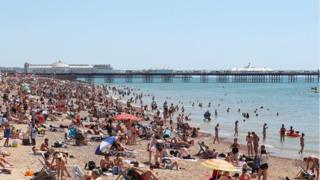 Image copyright
Gareth Fuller/Pa Media
Image copyright
Gareth Fuller/Pa Media
People are being warned to take extra precautions in the scorching sunshine - as the UK is expected to see a record level of UV radiation during the day.
With temperatures forecast to climb to 33C (91.4F) in some parts of the country, the Met Office has said the UV level is a real concern.
On Wednesday, thousands enjoyed the sun at beaches on the hottest day of the year so far, with London hitting 32.6C.
UV rays can cause sunburn and other damage to the skin.
The south of England is expected to be where temperatures are most likely to go past 30C while Scotland and Wales will reach around 29C (84.2F). Northern Ireland is predicted to have a largely sunny day but slightly cooler than elsewhere.
Dr Lynn Thomas, medical director of St John Ambulance, said vulnerable people, such as young children or the elderly, should stay inside if possible - but she recognised it was tempting to go outside during the "lovely" weather.
"But make sure you've got plenty of sunscreen on, make sure you're wearing a hat, try and stay in the shade as much as possible and make sure you take plenty of cool drinks with you," she said.
Why is UV dangerous?
UV exposure will not just put you at risk of sunburn.
Excessive UV radiation from the sun is also strongly linked to increased skin cancer cases in fair-skinned populations worldwide - according to the WHO.
The amount of UV reaching your skin is not driven by the daily temperature. UV levels on a bright and breezy late April day will be about the same as a warm sunny day in August.
The high levels expected on Thursday would be similar to a hot day in southern Spain.
BBC Weather presenter Matt Taylor said there were exceptionally high levels of UV radiation, which could reach nine on the UV index. The UK normally sees maximums of six or seven during the summer.
He explained that it can be more of a factor given that these conditions are being seen in June rather than later in the summer.
"We have just gone past the summer solstice so the sun is higher in the sky," he said.
He added that an "exceptionally large depletion of ozone in the northern hemisphere", a recent lower level of pollutants and a current spell of high pressure were other factors that were helping to keep the skies clear, so that UV rays were not being interrupted